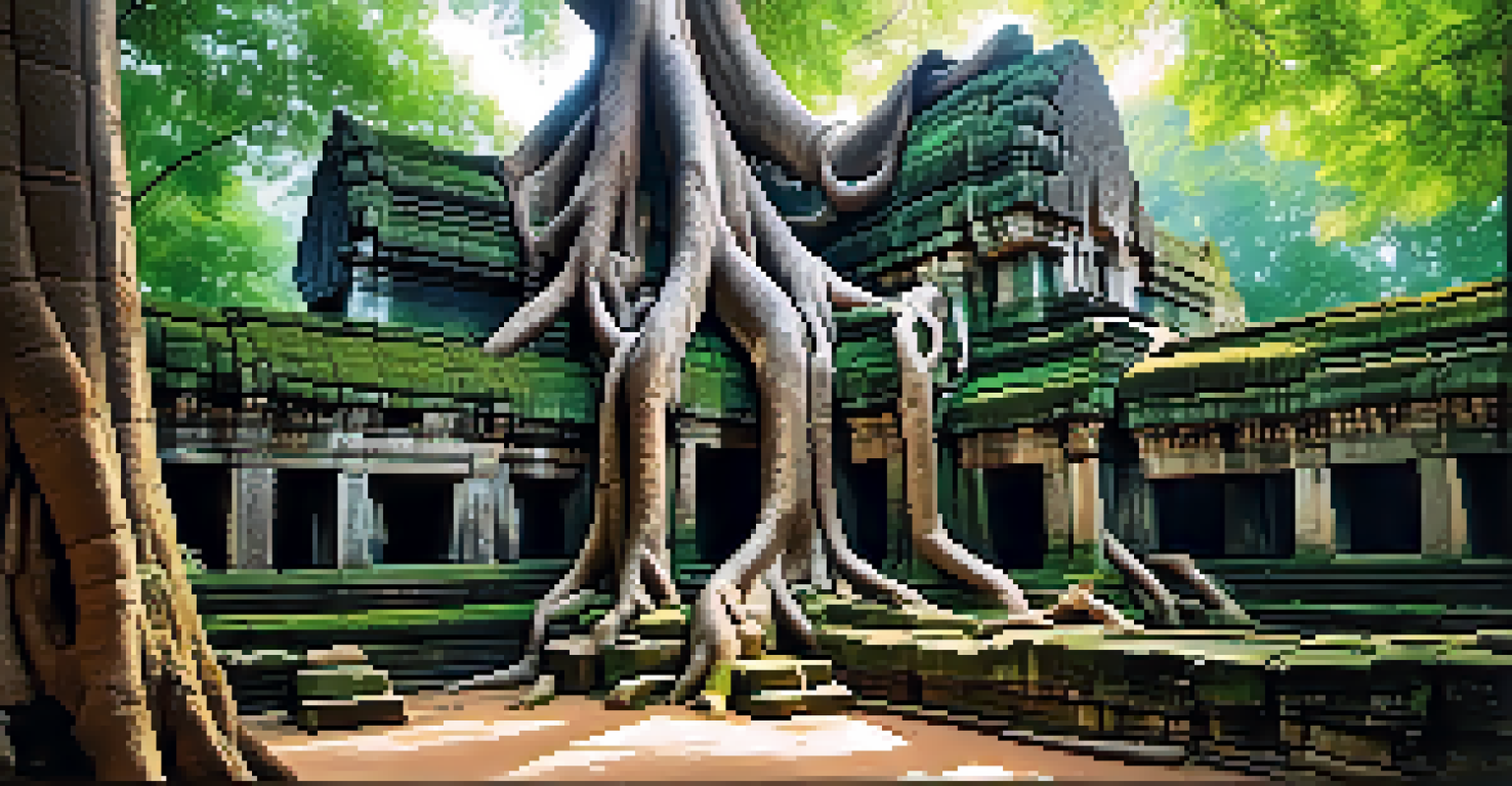The Temples of Angkor: A Glimpse into Khmer Civilization

Introduction to the Temples of Angkor
The Temples of Angkor, a UNESCO World Heritage site, are a stunning testament to the Khmer civilization that flourished in Southeast Asia from the 9th to the 15th century. These magnificent structures, located in present-day Cambodia, showcase the remarkable architectural and artistic achievements of the Khmer people. Angkor was once the capital of the Khmer Empire, and its temples reflect the empire's spiritual and political might.
The temples are a mirror reflecting the grandeur and complexity of the Khmer Empire.
Walking through these ancient ruins is like stepping back in time, where the intricate carvings and towering spires tell stories of gods, kings, and daily life. Each temple is a piece of history, revealing the beliefs and values of the Khmer civilization. It's no wonder that Angkor attracts millions of visitors each year, eager to uncover the mysteries of this iconic site.
In this article, we'll explore the significance of the Temples of Angkor, their historical context, and the rich culture that surrounded them. From the grandeur of Angkor Wat to the haunting beauty of Ta Prohm, each temple offers a unique glimpse into a bygone era.
The Architectural Marvel of Angkor Wat
Angkor Wat is the crown jewel of the Temples of Angkor and is renowned for its stunning architecture and intricate bas-reliefs. Built in the early 12th century, this temple was originally dedicated to the Hindu god Vishnu and later transformed into a Buddhist site. The grandeur of Angkor Wat lies not just in its size, but in its harmonious design, which reflects the cosmic world and the Khmer's deep spiritual beliefs.

As you approach Angkor Wat, the first sight of its five towering spires rising majestically against the sky is nothing short of breathtaking. The temple complex is surrounded by a vast moat, symbolizing the cosmic ocean, while the central spires represent Mount Meru, the center of the universe in Hindu and Buddhist cosmology. Visitors can spend hours marveling at the detailed carvings that depict epic stories from Hindu mythology.
Angkor Wat: Architectural Masterpiece
Angkor Wat exemplifies the grandeur of Khmer architecture and spiritual beliefs, with its stunning design and intricate bas-reliefs.
Angkor Wat's beauty has become an enduring symbol of Cambodia, appearing on the national flag and attracting art lovers and historians alike. Its preservation efforts are vital to maintaining this cultural treasure, ensuring that future generations can appreciate the stunning artistry and architectural genius of the Khmer civilization.
The Spiritual Legacy of Bayon Temple
Bayon Temple, famous for its enigmatic stone faces, is a masterpiece that embodies the spiritual essence of the Khmer Empire. Located at the heart of Angkor Thom, this temple was built in the late 12th century and is dedicated to the Buddha, showcasing the transition from Hinduism to Buddhism in the region. The 216 smiling faces carved into the stone are believed to represent Avalokiteshvara, the bodhisattva of compassion.
Angkor Wat is not just a temple; it's a symbol of the resilience and spirit of the Cambodian people.
As visitors wander through Bayon, they are often struck by the sheer scale and complexity of the temple's design. The layout is intentionally labyrinthine, inviting exploration and contemplation. Each face, with its serene expression, seems to follow you as you traverse the ancient corridors, creating a sense of connection to the spiritual world.
Bayon's bas-reliefs are equally captivating, depicting scenes of daily life, historical events, and celestial beings. These intricate carvings provide valuable insights into the culture and society of the Khmer people, making Bayon a must-visit for anyone seeking to understand the spiritual legacy of the Khmer civilization.
Ta Prohm: Nature and Architecture Intertwined
Ta Prohm is one of the most iconic temples in Angkor, known for its breathtaking blend of nature and architecture. Unlike other temples, Ta Prohm has been left largely in its natural state, with massive tree roots entwining with stone walls and structures. This haunting beauty has made it a favorite among photographers and filmmakers, providing a glimpse into how nature can reclaim man-made creations.
Originally built in the late 12th century as a Buddhist monastery, Ta Prohm was dedicated to the mother of King Jayavarman VII. The temple's unique aesthetic showcases the Khmer's reverence for nature, as the trees and ruins coexist harmoniously. Walking through its corridors feels like stepping into a fantasy world, where the past and present intertwine.
Bayon's Spiritual Essence
Bayon Temple's iconic stone faces reflect the spiritual transition from Hinduism to Buddhism, showcasing the cultural legacy of the Khmer Empire.
The preservation of Ta Prohm is crucial, as it highlights the balance between human innovation and the natural environment. Efforts to maintain this temple while allowing nature to flourish serve as a reminder of the fragility of cultural heritage in the face of time and change.
The Cultural Significance of the Temples
The Temples of Angkor are not just architectural wonders; they are also a reflection of the rich cultural heritage of the Khmer civilization. Each temple served not only as a place of worship but also as a center for community gatherings, education, and artistic expression. The artistic styles seen in the temples, including sculpture, painting, and architecture, influenced cultures throughout Southeast Asia.
The rituals and ceremonies performed within these sacred spaces are integral to understanding the spiritual life of the Khmer people. Festivals, offerings, and prayers to deities were commonplace, reinforcing the connection between the people and their beliefs. The temples acted as a backdrop for these cultural practices, creating a vibrant tapestry of life in ancient Angkor.
Today, the ongoing significance of these temples can be seen in the preservation of traditional arts and crafts, as well as in the continued spiritual practices of modern Cambodians. The Temples of Angkor are a testament to resilience and cultural identity, reminding us of the importance of heritage in shaping a nation's character.
Conservation Efforts and Challenges
As the Temples of Angkor continue to draw millions of visitors each year, conservation efforts have become increasingly vital. The impact of tourism, combined with natural erosion and climate change, poses significant challenges to the preservation of these ancient structures. Organizations, both local and international, are working tirelessly to protect and restore the temples while promoting sustainable tourism practices.
One of the major initiatives includes the use of modern technology, such as 3D scanning and modeling, to document the temples accurately. This data helps in planning restoration projects and monitoring the condition of the structures over time. Additionally, educating visitors about responsible tourism can help minimize the impact on these fragile sites.
Conservation Challenges Ahead
The Temples of Angkor face significant challenges from tourism and climate change, making conservation efforts crucial for their preservation.
Despite these efforts, the future of the Temples of Angkor remains uncertain. Balancing the needs of tourism with preservation will be crucial to ensuring that this incredible cultural heritage endures for future generations to explore and appreciate.
Visiting the Temples: Tips for Travelers
Visiting the Temples of Angkor is a once-in-a-lifetime experience, and a little planning can go a long way in making the most of your trip. Start by purchasing a temple pass, which grants access to the complex for one, three, or seven days. This allows you to explore at your own pace and soak in the beauty of each temple without feeling rushed.
Early mornings are particularly magical, as the soft light casts a golden hue on the stones, and the crowds are fewer. Watching the sunrise over Angkor Wat is a breathtaking sight that should not be missed. Additionally, consider hiring a local guide who can share fascinating insights and stories about the temples' history and significance.

Lastly, wear comfortable clothing and sturdy shoes, as you'll be doing a lot of walking. Hydration is key, especially in the tropical heat, so carry water with you. With these tips in mind, you're sure to have an unforgettable adventure exploring the wonders of the Temples of Angkor.